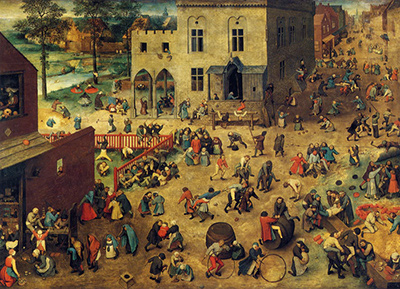Children's Games is an oil-on-panel painting by Flemish renaissance artist Pieter Bruegel the Elder, painted in 1560.
The painting is set in a town square, a wide street leading the viewer’s eye from the rural scenery of the background, into the urban setting of the foreground. Here over two hundred children are shown playing over eighty different children's games. Some games are still recognisable today, such as: playing with dolls, hobby horses, marbles and Blind Man’s Bluff. Bruegel has chosen a realistic depiction of children and their behaviour. Many of the children are happily engaged in playing, but there are groups involved in hair pulling, wrestling and rough play.
One such group is playing Run the Gauntlet, a game which involves someone running through the middle of a tunnel of children all kicking their legs. There are also representations of seasonal games. Some children are wearing paper crowns and carrying a duivekater loaf, associated with the mid-winter Feast of St Nicholas. Another group is acting out a mock wedding, possibly to represent May Day customs. Although Bruegel had painted other pictures depicting peasant life, this one is unique in featuring predominately children, which was uncommon during this period.
There is no information regarding who commissioned the original painting and this had led to lively debate regarding the meaning behind the painting. One popular theory states it is a moral comment, using children's games as a metaphor for the foolishness and folly of adults. An opposing idea, based on 16th century humanist theory, is that the painting shows the importance of play in children’s development. The painting itself can be seen as a kind of game; the small figures encouraging the viewer to look carefully to find as many games as possible.




